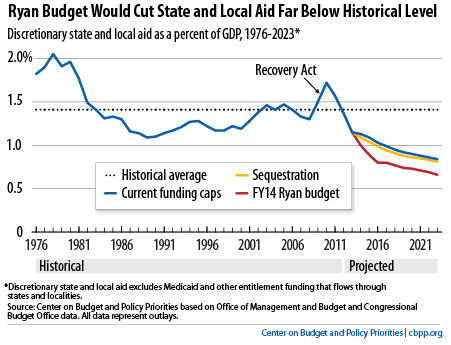off the charts
POLICY INSIGHT
BEYOND THE NUMBERS
BEYOND THE NUMBERS
Federal support for services that states and localities provide — schools, health care, clean water, and law enforcement, for example — would fall precipitously under the House-passed budget from Budget Committee Chairman Paul Ryan, our new report explains. These cuts would come on top of the deep cuts in federal funding for states and localities already scheduled under the 2011 Budget Control Act (BCA) and the automatic cuts known as sequestration that began to take effect this month.
- The Ryan budget would block-grant Medicaid and cut its funding by nearly one-third. The federal government would no longer pay a fixed share of states’ Medicaid costs; instead, states would get a fixed dollar amount that would fall further behind states’ needs with every passing year. Federal funding would drop 31 percent by 2023, relative to current law. These cuts would come in addition to the cuts from the Ryan budget’s repeal of health reform’s Medicaid expansion.
- The Ryan budget would cut funding for a range of other state and local services. It would cut non-defense discretionary (i.e. non-entitlement) funding — one-quarter of which goes to states and localities — by $256 billion over the ten years from 2014 through 2023. That’s an average of 18 percent below the already tight BCA funding caps. Our paper gives state-by-state estimates for the cuts in 2014 and 2014-2023 if they fall proportionally across this part of the budget.Policymakers could spare state and local funding and make all of the required cuts from purely federal areas of non-defense discretionary spending. But that would entail extremely deep cuts in veterans’ health care, biomedical research, border protection, the FBI, the Social Security Administration, and the like. Indeed, rather than spare state and local funding from cuts, policymakers likely would cut it by more than 18 percent in order to protect federal activities such as these.
- The cuts are much deeper than those under sequestration. The cuts to non-defense discretionary funding under the Ryan budget in 2014 would be nearly three times as deep as under sequestration. The difference would be even larger in later years.
- The Ryan budget likely would push federal funding for state and local services far below historical levels. By 2023, discretionary state and local grants would fall to an estimated 0.7 percent of GDP, half the average of the last 35 years (see graph).
Image

Topics:
Stay up to date
Receive the latest news and reports from the Center
